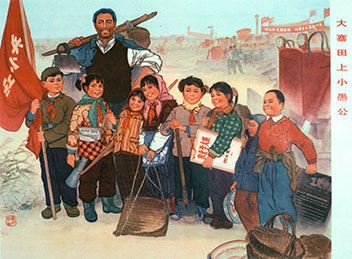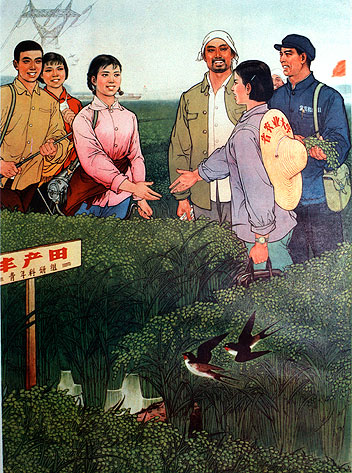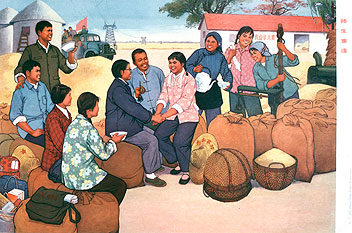Dazhai — Modernization of agriculture and rural areas
During the Cultural Revolution more than 80 per cent of China’s population was living in rural areas. Most of them were engaged in agriculture and a primary task was to grow enough grain to feed a growing population, and build up stockpiles for times when harvests would occasionally fail. After the failure of the Great Leap Forward the administrative unit in focus was no longer the People’s Commune. The brigade, the next lower level, often the equivalent of an earlier village, became the rallying point for mobilizing the rural masses in most parts of the country. The brigade Dazhai became the model for unselfish and successful cultivation under extremely harsh conditions. The model suggests self-sufficiency and great attention to water conservation.
Mechanization
The arrival of a tractor was in the early 1960s in most places a great event and the farmers were excited by the appearance of an “iron ox.” Year after year the numbers increased. One special model was the small walking tractor that had originated in Japan for ploughing paddy fields and other farming tasks, although in China widely used for transportation. In the early 1970s posters depict an (expected) abundance of tractors, harvester combines and even machines for rice transplanting. By the end of the 1970s China had almost two million small walking tractors and an annual production of 300,000 units, manufactured all over the country.
However, rice transplanting machines did not catch on at the time as farmers complained, aside from the costs, that they took away their jobs. More important were mechanical threshers in order for the farmers to find time for the next crop of the year. However, the introduction of agricultural machinery was not always accompanies by required maintenance and provision of spare parts. Aside from tractors machinery focus in rural areas has been on electrification and the development of small-scale industries (5 Small Industries) to meet local demand of cement, bricks, various machinery and chemicals, including fertilizer needed in agriculture.
Health and Education
Rural areas experienced many encouraging changes, despite the turmoil of the Cultural Revolution. Health care, usually a remaining responsibility under the people’s communes, improved for which so called “bare-foot doctors” played an important role. Local production of medical herbs received much consideration. However, the emphasis of grain production in almost all parts of the country led to neglect of cash crops. Towards the end of the period rural areas experienced an emphasis on serving the cities with vegetables, eggs and other agricultural produce, and an increasing emphasis on mass production and specialization can be observed.
Education in rural areas improved and illiteracy was reduced. Shops for serving the local population with daily commodities improved living conditions, although traditional rural markets were not encouraged. Towards the end of the period rural areas close to big cities and the large state-managed farms came to play an economically more important rule, while other areas developed more slowly. The growing discrepancy has increased when China emerged on its open-door-policy which emphasized a rapid development of coastal areas where foreign direct investment was to play a very significant role.

Go into Dazhai Fields as Little Yugong (The Foolish Old Man who moved the Mountain) (311-48-48)

Rich Harvest (315-38-358)

Teacher and Student Reunion (312-59-139)

Receiving the Bride (Tractor) (312-19-99)
